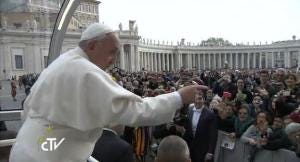Part of the Crowd on Palm Sunday
Ever since I signed up to do Daily Theology’s post for Palm Sunday, I’ve kind of been dreading it. One, as regular attendees of Palm Sunday liturgies know, the readings are particularly long, and I’m getting to the end of the semester here.
Two, the trial before Pilate in the various gospels is one of the places where the problems of the Christian portrayal of “the Jews” are most pronounced. And while Matthew’s Gospel (which is the cycle for today) doesn’t us the term “The Jews” the way John’s Gospel does, I still recommend keeping in mind Sonja’s great post at WIT on “Reading ‘The Jews’ in the Sunday Readings.”
Third, I don’t entirely understand why the readings for Palm Sunday include the passion narrative. Yes, I get that there is also “Passion Sunday,” and so the two are tied together. But I don’t know why the two are connected (and honestly, those with more liturgical awareness or history on this, feel free to let me know in the comments). So far, my best insight sees a connection between how “the crowd” is portrayed in the two readings from Matthew.
The reading at the beginning of the Palm Sunday service is about Jesus’ entry into Jerusalem. Jesus’ chosen form of transportation recalls Zechariah 9:9:
Exult greatly, O daughter Zion!
Shout for joy, O daughter Jerusalem!
Behold: your king is coming to you,
a just savior is he,
Humble, and riding on a donkey,
on a colt, the foal of a donkey
Further , the crowds’ spreading “their cloaks on the road” recalls 2 Kings 9:11-13:
When Jehu rejoined his master’s servants, they asked him, “Is all well? Why did that madman come to you?” He replied, “You know that kind of man and his talk.”
But they said, “Tell us another lie!” So he told them, “This is what the prophet’s aide said to me, ‘Thus says the LORD: I anoint you king over Israel.’”
At once each took his garment, spread it under Jehu on the bare steps, blew the horn, and cried out, “Jehu is king!”
So according to Matthew, the crowd recognizes Jesus as a king and a prophet (or, as I sometimes tell my students, “Like a boss”). In cheering “hosanna,” they are celebrating his entrance. All in all, the crowd seems to be on Jesus’ side.
Later, the Gospel reading at the service is from the trial and crucifixion of Jesus. Here, the depiction of the crowds is as opposed to Jesus: Judas returns “accompanied by a large crowd,” the crowd is persuaded to request Barabbas’ release instead of Jesus, and then the crowd (again, according to Matthew) claims responsibility from Pilate for Jesus’ crucifixion. Although we can make no assumptions about who is in “the crowd” in these two readings, the crowd seems to have resolutely turned against Jesus.
I think it would be easy at this point to go one of two ways in reading this comparison of the crowds. One is the straightforward pitch we give to teenagers: “Don’t give in to peer pressure! Don’t just be a part of the crowd!” Alternatively, we might say: “Remember, you are a part of the sinful crowd that is responsible for Jesus’ death. He died because of you.” These aren’t the worst messages ever, and odds are many of you will hear one or the other of these homilies this weekend.
But, I want to shift to something else entirely in thinking of the crowds. There was a nice Pope Francis moment this past week, where a person in the crowd shouted to Francis “there’s nobody like you!” In response, Francis yelled back “You too! No one like you!”
When I read this story, it made me think “image of God.” What I think Francis is highlighting here is the wonder and delight of each individual person. And although each member of the crowd is unique – “no one like you” – each is also made in the image of God. We thus ought to recognize that wonder in each person and the gifts that each person can bring.
Paragraphs 39-42 of Lumen Gentium describe a “universal call to holiness,” a holiness of which Christ “stands as the author and consummator.” When the crowds at Jesus’ entry in Jerusalem sang “hosanna,” they said also “blessed is he who comes in the name of the Lord.” While this is fairly clearly a reference to Jesus in this moment of praise, maybe it’s worth thinking about this Palm Sunday that we “who come in the name of the Lord” are blessed as well. We who pursue our own specific, unique form of the vocation to holiness are enabled and empowered by grace to do so. And to pick up on this imagery of “the crowd,” maybe we can think of the crowd we are called to be a part of, the body of Christ, and what it means to be a blessed part of that crowd called to our own unique vocation of holiness. Then finally, I can see that even though there’s no one else like me or like you, we can be the many diverse parts of that one crowd, that one body.




